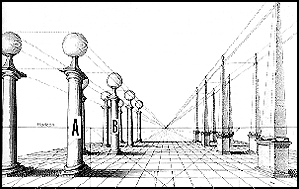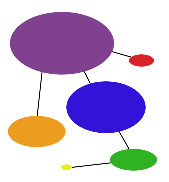
Data visualization is the way in which information is presented. Visually, this is represented by basic shapes to more complex graphics. There are five subdivisions: Proportion, Dimension, Direction, Texture, and Shapes.
The size of an image on a page, graphics in relation to text and other graphics and the depth of an image are important factors to consider.
Relationships - The size of a graphic in relation to elements on the page and to the page itself is an important consideration. A graphic that takes up a large portion of the page conveys to the reader a sense of importance; his eye will be drawn to the image first over all other content. Also, the relative size of graphics will show the reader which elements are more important or deserve more focus.

In the picture above, the eye is drawn to the lager objects first, then notices the smaller objects. The author of this is giving the impression that what is represented/contained by the larger image is most important and should be viewed first.
Two dimensional objects can be manipulated to look three dimensional through the use of Linear Perspective and Chiaroscuro.
Linear Perspective - "The technical convention of linear perspective is a Renaissance invention. It is a systematic, formalized method of representation that allows the artist or designer to simulate depth with a few scant lines. It operates on the premise that objects appear progressively smaller the farther away they are. Lines that extend out into space converge at one or more vanishing points on the horizon line, which coincides with eye level." - The On-Line Visual Literacy Project

Chiaroscuro - The use of light and shadow. It is through the dramatic emphasis of highlights, reflected light, and cast shadows that chiaroscuro achieves its desired effect.
"When we look at an image our eye travels around the frame exploring the contents. Direction will play key role in our understanding the meaning of this image. The amount and type of motion created by various shapes and lines can convey different emotional states and the direction of that motion will contribute the intensity of the emotional response." - The On-Line Visual Literacy Project
Direction of a Shape
How the viewer is moved through the site - how the viewer moves within the space. The placement of images and text pushes the viewer in a certain direction. The combination of the five data visualization elements comes into play here.
"If someone were asked to define texture, they might reply, ". . .the feel of an object's surface." This is an example of the way in which we often assume texture is something which must be physically felt in order to understand it. Texture is something which we feel when we interact with our surroundings. But, our understanding of texture is not limited to touch. Texture can be "felt" with our eyes also.
The visual element of texture must be looked at first from a tactile standpoint. If one picks up a peach, one may say that it feels, "soft." Likewise, if one looks at a picture of peach, one might say that it looks, "soft." This is because our sense of touch cooperates with our eyes to give us a better understanding of our surroundings. Just as the fingers can sense that a rock may have a rough and coarse surface, the eyes can also pick up the small variations in texture before even being touched. This has great significance in the world of visual arts and literacy. If the element of texture is more understood, then a more "hands-on" approach can be given when observing the intense visual world which we live in today." - The On-Line Visual Literacy Project
"Soft" - smooth looking, lack of detail
"Harsh" - interrupted, sharp, contrast
"Reading shapes, we tend to dissect them into simpler forms based on geometrical units. Most people can immediately perceive the total area of a circle, a square, a triangle, an oval, or a rhombus, without difficulty. If we were shown an image for a couple of seconds, we probably would not be able to remember it in all the details, but we would have a general grasp of it's basic form.
We can say that the geometric basis of shapes provides us with an elementary vocabulary, an alphabet of the shape language. It helps us to dissect, analyze, and structure the world.
Besides that intellectual perception, restricting our view of the outside world to things of practical interest and immediate necessity, we have a spontaneous vision of shape, the capacity to be surprised, enchanted, or impressed by it's visual phenomena. We respond to them emotionally. They hold for us their own expressive meaning and character.
Different shapes tell us different stories. The endless variations and interplays are stimulating our curiosity constantly. The sensory perception of shape is probably connected with the deepest levels of our perception of the world. It is universal, and can be understood beyond the limits of the cultural identity." - The On-Line Visual Literacy Project
Circle - calm, pacific, assured, natural, optimistic. example: the sun
Square - dull, straight forward, honest, lacking imagination, stable, less natural than the circle. example: a skyscraper
Triangle - action, agitation, conflict, tension, and aspiration. example: the Pyramids, arrowheads